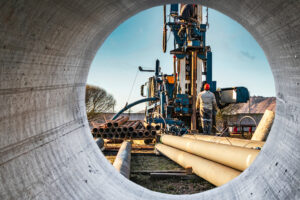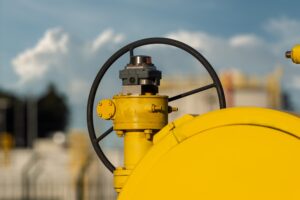Pipe storage is so important because the oil and gas industry relies on miles of high-strength, pressure-resistant pipe to transport its products from the drilling site to the oil refinery or gas distribution center. Any flaw in the piping system, such as a leak at a junction, a crack, or a hole in the pipe itself, represents not only the loss of a valuable resource but also a serious risk to the environment.
Consequently, oil and gas companies depend on high-quality products that ensure the integrity of their oil country tubular goods, especially during pipe storage and transportation.
Risks Inherent in Pipe Storage
When pipes are in storage, they are stacked in pipe storage racks. During the stacking process and during transportation, pipes are in constant contact with each other. This creates the potential for impact or friction, which can damage the surface of a pipe. Damaged metal is more vulnerable to corrosion from exposure to moisture, contaminants, or the extreme heat and cold that oil and gas pipes often endure. Fortunately, there are several products designed to minimize motion and contact between pipes.
Storage Racks
The design of the storage system is an important aspect of pipe protection. A secure pipe rack should be the correct size to support the length, diameter, and weight of the pipes you need to store or transport. Some storage systems require pipes to be fastened to the system with tools, but there are also racks available that are designed to support pipes securely with adjustable blocking. The material of a storage rack should be strong, flexible, and UV resistant.
Bumper Rings
These thin rings are fitted snugly around the outside of the pipe, typically at both ends and in the middle. Just like the bumpers on a car, the rings protect the pipes from impact with each other.
Pipe Chocks
Pipe chocks are pyramid-shaped wedges placed underneath a pipe on either side to hold it in place, often at multiple locations along the length of the pipe. If you’re using a storage rack that does not hold each pipe individually in wedged slots, it’s very important to use pipe chocks throughout a stack to eliminate motion.
Thread Protectors
Thread protectors are fitted to the ends of pipes to protect the metal threads from wear and corrosion. Made of durable plastic, thread protectors effectively prevent corrosion from contaminants, weather conditions, and extreme temperatures. Protecting the ends of pipes ensures that they remain functional and leak-proof throughout their lifespans.
Pipe Storage Compounds
In the event that small nicks and scratches occur, compounds can be used to fill these spots and protect them from any further damage. Storage compounds prevent corrosion and can be used whether or not any damage has already occurred.
Take It from The Experts @MSI
MSI Pipe Protection Technologies leads the industry in top-of-the-line protection for oilfield products. Using high-quality composite products, MSI can provide precision CNC-machined threads according to industry standards or a custom design. We test all of our pipe protection products for durability, resistance to UV radiation, impact, vibration, and extreme temperatures, as well as corrosion and fit. Call us today!




